World Water Day – Sharing the Nexus
By: Lindsay Kline and Victoria Pleavin

Every year on March 22nd, citizens from all over the globe celebrate World Water Day to recognize the importance of this vital resource. Established in 1993 and led by the United Nations (UN), World Water Day continues to shed light on water issues and opportunities for taking action to advocate for sustainable water management.
In Alberta, we celebrate the pristine rivers whose headwaters begin in the Rocky Mountains and travel through the Province; sustaining people, communities, industry, and the environment. We also celebrate the lakes that provide citizens with a place to reflect and recreate. With these water resources, we are able to enjoy our natural surroundings while benefiting from a high standard of living.
On this World Water Day, however, we pause to consider the future health of local, national, and global water resources. As populations continue to grow, demands for energy, food, and community development also increase. The Nexus Concept is becoming an increasingly used phrase for describing the interconnectedness and interdependency of our global resources; including water, food and energy. On World Water Day, it makes sense to think about how the Nexus Concept specifically relates to water, as the convergence of different water demands result in the need for planned sharing of finite local — and ultimately global — water resources.
Within the borders of our own province of Alberta, we can see that competing water demands have already begun to converge and overlap. Since the closure of the South Saskatchewan River Basin to new water licenses in 2006, several communities have started to push the limits of their water allocations and some businesses (such as the CrossIron Mills shopping outlet to the north of Calgary) almost failed to get off the ground due to a lack of water. With increasing demands for water to support growing communities, industrial activities, agricultural production and recreation, it becomes clear that the demands will inevitably converge in basins throughout the Province, resulting in less water to go around.
To address this convergence – or nexus — of demands, a different way of thinking about water management will be required. Specifically, trade-off decision making would enable water managers at all levels to address the entire system of water uses, rather than looking at the individual parts in isolation. To add to the complexity, Albertans are increasingly concerned with issues like extreme weather, flooding and drought – symptoms of a changing climate. A systems way of thinking, based on the Nexus Concept, would enhance collaboration throughout Alberta’s basins and help to address the complex nature of how to ensure a sustainable water supply for people, food, energy, and the environment.
World Water Day provides citizens with the opportunity to not only celebrate the water we have and the life it supports, but also to step back and consider the changing issues facing our water resources and how the Nexus Concept can be applied when seeking solutions for those issues. In Alberta, we are fortunate that we are still in a position where we can study, discuss, and plan for addressing competing water demands in the face of a changing climate. While the future is uncertain and the challenges seem daunting, there is considerable work and thoughtful effort being put into water, which leads us to believe our glass is still half full.
For more information about the Nexus Concept, click here. We thank the following project funders for their generous support of this work
Practical implications of COP21
 By Edwin Piñero
By Edwin Piñero
It’s easy to get lost in the lofty language of the recent COP21 climate agreement discussions and texts; but what does it mean for us practically? There’s justifiable frustration and skepticism that once again, this grand meeting will not produce substantive results. But the real variable of consequence is what happens after the COP21 meetings—what can and will actually be done to reduce greenhouse gas (GHG) emissions?
Even if money is available and monitoring, reporting, and verifications protocols are all worked out, nothing can be accomplished unless actual practices are put in place that result in lowered GHG emissions. I contend there are at least two game changers to realize these results.
One is making the business case for implementing practices and technologies that lead to lower emissions. Well-defined practices and applicable technologies still need a compelling business case as government mandates will only go but so far. To truly catalyze action in all sectors, a strong business case is necessary to mobilize capital and prompt “voluntary” (rather than government forced) actions.
The other game changer is the distinction between mitigation and adaptation strategies. The Earth’s history tells us the climate changes as a natural process. While human-induced climate change may be a variable, it’s foolhardy to think that controlling GHG emissions to a specific level from society (fossil fuel use, industrial processes, and so on) will eliminate all risks.
Therefore, we need to think about mitigating GHG emissions, and we must also think about adaptation strategies to inevitable climate changes. In a way the business case and adaptation points are related, as being adaptable and mitigating risks is part of survival and, even with ambitious announcements by world leaders, no business can rest on their laurels when it comes to dealing with the future.
The need for a business case
A sticking point at COP21 about where to source funds to help some countries meet goals is a telltale sign, notwithstanding the moral and noble intent, that without a business case it’s a hard sell. Veolia supports a carbon tax, or some type of fee, for carbon emissions because we can provide a business driver for action, especially from the private sector. As with any raw material or waste stream, knowing the cost and financial value allows the business case to be made for optimal and sustainable actions. Industry and public sector entities, and nearly all citizens in one way or another, pay to buy materials and dispose of solid and waste water. Why not have to pay for carbon emissions as part of this system?
If the argument is that GHGs impact the environment, and therefore need to be at least managed and ideally reduced, then a cost of carbon would recognize the implications of these impacts, as well as provide a foundation for business cases.
Adaptation versus mitigation strategies
Much has been said about actions to reduce GHG emissions so resulting climate change is not as severe or frequent. But at the city, company, site, and organizational levels, actions are needed, not only to reduce emissions but to also ensure cities, companies etc. are protected from inevitable climate related impacts. Yes, the climate is changing, and regardless of where you stand on GHG reduction commitments you need to plan for change. For example, Veolia operates energy and water infrastructure. Floods, severe storms, droughts, and rising sea levels can all impact our infrastructure, so we need to plan for such weather events.
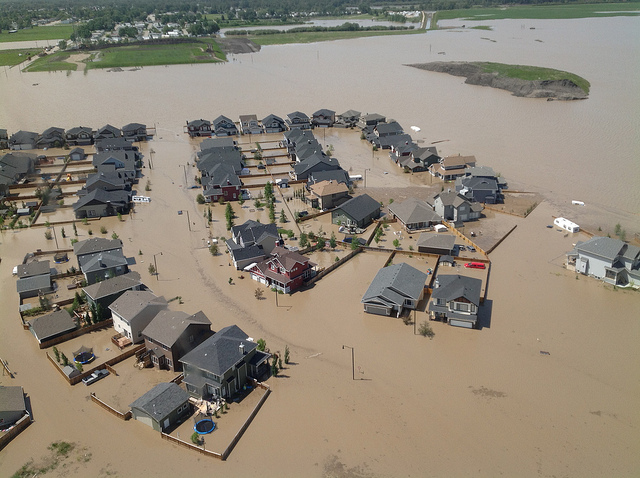 |
| “IMG_0315” by Town of High River is licenced under CC BY 2.0 |
As an organization we see our role as implementing technologies and practices that help reduce GHG emissions in a sustainable manner. This means implementation in a way that makes sense in terms of the environment, our society and quality of life, and our economies. We also develop methodologies and tools that help assess the impacts and risks of climate change and monetize those risks. With this information, an organization, public or private, can more easily compare the cost of not doing anything versus taking action.
How are these business case and adaptation issues relevant to Alberta?
Firstly, Alberta’s economy depends on both the energy sector and agriculture. Ironically, these are two sectors closely tied to climate change: the energy sector because of the issue of fossil fuel contributions to GHG emissions reductions, and agriculture because of the impact from climate change and how that affects food security.
For agriculture it’s more complex than we may think. Yes, climate related impacts such as drought and flooding affect crops and livestock, and therefore food security. But agriculture accounts for 70% of freshwater use and it takes energy to manage water. So providing this significant water supply to agriculture, and to account for other water use demands, will take energy. We also know energy production and use emits GHGs. For changes in agriculture to adapt to climate changes, we need to also consider the corresponding energy footprint and what that means for GHG. For example, pumping irrigation water longer distances to account for drought, or needing to desalinate water, will mean more energy demand. Practices and technologies that can do this more efficiently, or with alternative methods that result in lower GHG, will be paramount. More drought risk adaptation, such as reused water for irrigation, will be a must.
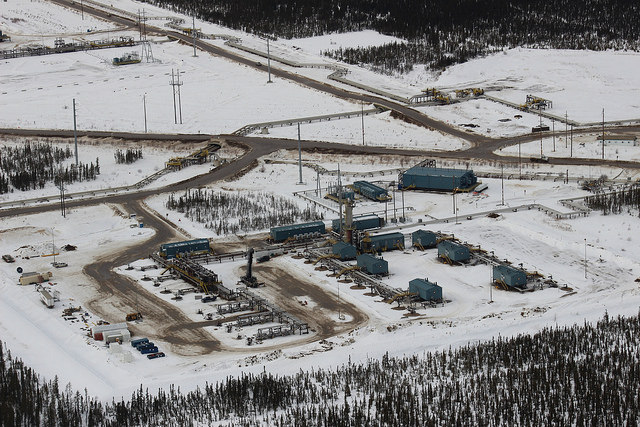 |
| “Suncor Firebag” by jasonwoodhead23 is licenced under CC BY 2.0 |
For the energy sector in Alberta, the ability to produce oil with a lower carbon footprint is necessary. The pending carbon caps and tax proposed for the province will help form the business case for more efficient production. It’s interesting that the greatest GHG impact of oil sands production comes from steam generation (done mainly using natural gas). More efficient steam generation and alternative energy sources will help the oil sands sector keep production as economical as possible. With low oil prices, any savings, such as not paying a high carbon tax, will go a long way. The oil sand sector has to also consider adaptation strategies. With receding glaciers and reduced river base flows, a steady water supply could be at risk. Adaptation strategies such as water reuse may be a key solution.
The reality is fossil fuels will remain a notable component of the energy mix, not only in Alberta, but also across Canada and the entire world for that matter. Strategies and practices that can sustainably produce these fossil fuels will continue to have a place going forward for some time.
So where are we now?
We’re in a similar place to where we were after previous COP meetings. Yes, agreements are important and national commitments are a necessity. However it all comes down to what will actually be done to mitigate GHG emissions, and how we adapt to inevitable climate change (and related impacts) that will occur even with lower GHG emissions from society.
While we have a single, global atmosphere, and while COP21 will attempt to achieve global scale commitments, in large the real results will be driven by national, city, company, and organizational level actions, supported by good business cases and adaptation strategies.
Edwin Piñero is Senior Vice President Sustainability and Public Affairs, Veolia North America.
Where water fits in COP21
By Kristy Dixon
Climate change and carbon emissions are top of mind due to the COP21 conference in Paris. It’s also a timely topic of discussion for many Canadians, and especially Albertans, given the provinces’ recently released Climate Change plan.
COP21 (known less colloquially as the 2015 Paris Climate Conference) is the 21st international conference on climate change. The conference boasts attendance of 190 countries, each of which are trying to reach collective agreement on limiting the impact of climate change. To the point, delegates are attempting to agree on ways to prevent the planet from warming more than two degrees by 2100.
Often when we see and hear about climate change its impacts are conveyed through water—time lapses showing receding glaciers, miserable images of drought, and footage of coastal communities under threat. While water is a universal resource that all people can use to relate to the impacts of climate variability and warming, it remains secondary to energy in climate talks, and is often approached as a sub-section to an overall carbon focus.
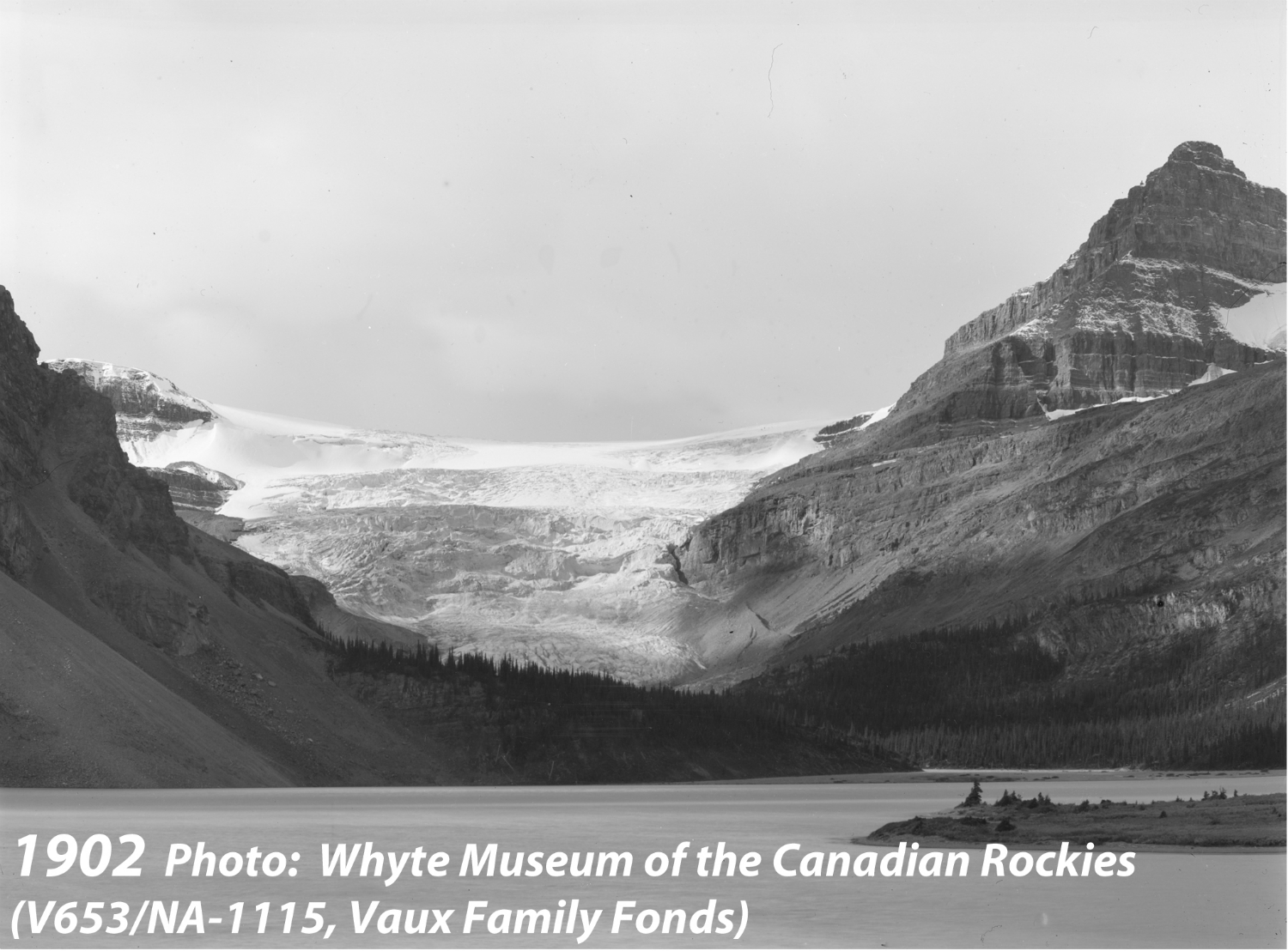 |
 |
| Bow Glacier in Banff National Park | |
Most importantly, the integral relationship between climate and water means the commitments from COP21 will have impacts on how we manage water. For Albertans the commitments starting to flow out from COP21 might, at first, not seem directly relevant to our water management. However, the global focus presents opportunities to share, learn, and refine prevention and mitigation strategies, especially around extreme weather events including flood and drought, and the challenge of water scarcity.
Here are some key topics in COP21 and examples of how they relate to water:
Greenhouse gas emissions
It is no secret Canadians are some of the most wasteful people when it comes to how water is used. Furthermore, this is bad news for greenhouse gas emissions.
For example, before water reaches a home or business in Canada it must be extracted, treated, transported and, once it has been used it, must again be transported, treated, and released. Every one of these steps takes energy. To achieve this, municipalities typically spend between 25 and 60% of their budgets to supply energy for their city’s water infrastructure [1].
Local reuse could help to reduce water use; however, treating domestic and industrial wastewater also creates significant greenhouse gas emissions. For example, the treatment of used household water from cooking, washing, cleaning, and sanitation alone accounts for 3% of global electricity consumption and 5% of global non-carbon dioxide greenhouse-gas emissions (mainly methane). Methane’s comparative impact to carbon dioxide is more than 25 greater over a 100-year period, making it quite the nasty emission [2].
Solutions aren’t easy to come by, and require a mixture of prevention, mitigation, and conservation, to reduce overall greenhouse gas emissions for water usage.
Some say an easier win would be reducing greenhouse gas emissions produced through the production, transportation, and waste created through bottled water, as estimates reveal producing bottled water requires as much as 2,000 times the energy cost of producing tap water [3]. A little ironic considering popular bottled water brands like Dasani and Aquafina are essentially tap water treated for aesthetics.
With water scarcity (and therefore quality) linked to water treatment, and water treatment linked to energy, it will be interesting to see if COP21 addresses these relationships to water in the current or future climate talks.
Sustainable agriculture and forestry
At COP21, a panel is considering sustainable agriculture, forestry, and their use of water. These competing demands for the world’s most valuable resource are referred to as the Water Energy Food Nexus.
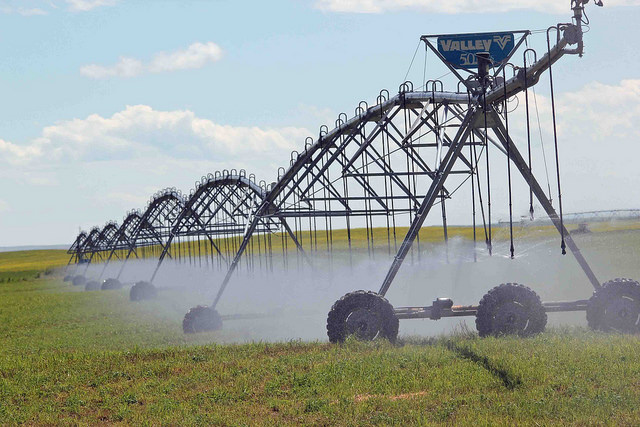 |
| “Irrigation 2144″ by Marcia O’Connor is licenced under CC BY 2.0 |
Agriculture is one of the sectors most seriously affected by climate variability but it also accounts for 24% of greenhouse gas emissions, which cause climate change [4]. It makes sense to break this futile loop, and water conservation and smart technologies for agricultural water use could be the biggest circuit breaker. When it comes to water, agriculture consumes 70% of freshwater used by humans, much of which is sourced from non-renewable aquifers [5]. Improved monitoring and expanded regulation could improve this number.
The forestry industry has growing awareness of the need to consider watershed management as a tool for developing plantations that focus on forest productivity, as well as environmental and social benefits, mainly in terms of maintaining water supply and water quality to downstream users [6]. The industry is also questioning local watershed impacts including erosion, flood, and fire implications.
Emission tradeoffs
Similar to greenhouse gas emissions, as soon as tradeoff conversations become more detailed, water becomes an implicit consideration. Take hydraulic fracturing for example: at an Alberta Water Conversation event in 2013 attendees largely agreed that fresh water should not be used for fracturing and that saline water would be a better choice. However, questions quickly arose on where saline water is located in relation to a well, and the transport implications of shipping saline water, or the energy required to create fresh water from a saline water source. This shows how quickly emissions tradeoffs and water become complicated.
Ultimately, decisions in climate impact water and decisions in water impact climate. To address these issues, communities and decision-makers are increasingly taking a holistic approach to these systems, not only trying to prevent global warming, but introducing ways for communities to adapt to the increasing climate variability that is forecast around the world, including in Alberta.
At COP21, the United Nations say it themselves, “Adaptation to climate change is closely linked to water and its role in sustainable development.” [7] Water may not be the headline from COP21, but it will be a clear indicator of how effective actions from the conference, and how effective subsequent regional or local initiatives will be, against the targets set.
Kristy Dixon is a Communications Specialist at Alberta WaterSMART.
Sources
[1] https://environment.yale.edu/yer/article/water-usage-in-cities-tied-to-greenhouse-gas-emissions
[2] http://www3.epa.gov/climatechange/ghgemissions/gases/ch4.html
[3] http://iopscience.iop.org/article/10.1088/1748-9326/4/1/014009/pdf;jsessionid=DDCA958D362B5FD7F2F853B6C674F1A7.c1.iopscience.cld.iop.org
[4] http://www.un.org/apps/news/story.asp?NewsID=52699#.Vl-x-eOfrGc
[5] Pimentel, D., Berger, B., Filiberto, D., Newton, M., Wolfe, B., Karabinakis, E., Clark, S., Poon, E., Abbett, E., Nandagopal, S. (2004). Water Resources: Agricultural and Environmental Issues. Bioscience, 54, 909-918.; Rost, S., Gerten, D., Bondeau, A., Lucht, W., Rohwer, J., Schaphoff, S. (2008.) Agricultural green and blue water consumption and its influence on the global water system. Water Resources Research, 44, 1748-9326.
[6] http://www.hindawi.com/journals/ijfr/2012/908465/
[7] http://www.unwater.org/topics/water-and-climate-change/en/
Six tricky questions about flood insurance in Alberta
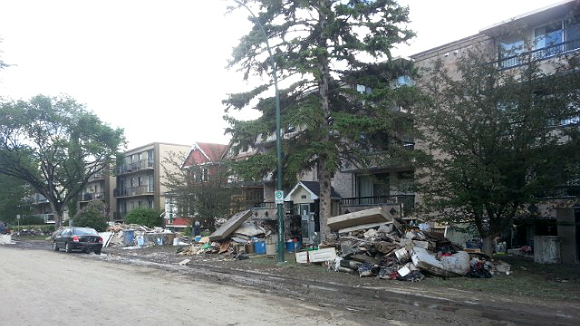
Recent significant floods and the predicted increase of extreme weather events have many Albertans, from insurance experts to governments to property owners, talking about flood insurance.
Throughout these conversations the same basic, but tough, questions continue to rise. We don’t know all the answers, but here are the questions as they relate to the current situation and developments.
1. How do you define a flood?
Is a flood a specified volume down the closest river? Overland water only? More than five basements flooded in one community? Groundwater infiltration? When a provincial disaster is declared?
The Insurance Bureau of Canada states that in general, overland flooding resulting in water entering a home is not covered. Overland flooding usually occurs when bodies of water, such as rivers, dams, and other watercourses, overflow onto dry land and cause damage.[1]
There are also differences for insurance between flood damage and water damage.
What is clear is that consensus on the definition of a flood would enable consistency in policy development, education, and coverage levels for the large number of stakeholders impacted by flood insurance including the Alberta public. Once a flood is defined, you can narrow down what can and can’t be covered in the event of damage.
2. Who owns flooding risk?
When floods subside there’s usually plenty of finger pointing on what could’ve been done, who’s responsible, and what needs to be done to avoid the damage of future floods. However, the crux question is who owns the risk?
If we look at an existing house on a floodplain, there were multiple parties involved throughout the steps leading to the development, approval, construction, purchase, insurance, and renovations or other property work. Because there are so many diverse stakeholders and circumstances it’s unlikely there will ever be a single body, or owner, responsible for flood risk (or its management) in Alberta.
So, if there isn’t one owner of the risk, it has to be shared – and how that works is yet another question! Looking around the world it’s common for flood risk to be shared across levels of government, private insurance companies, and individual householders. This would require a strong collaborative and inclusive approach to developing flood risk and management in a province like Alberta.
However there’s more to that challenge, as how people work together is influenced by their own perception of a particular issue. When it comes to risk, in many cases, people’s perception is often to underestimate it.
Programs like Disaster Financial Assistance Arrangements (DFAA) have also impacted people’s perception of risk, building an expectation for some people that someone else, like the government, should cover the costs of their loss. In theory the government has obligations to support the public; however this approach exposes all taxpayers to large costs in the event of a disaster and potentially undermines private insurance efforts.
To revisit the question of who owns flooding risk, there needs to be a balanced distribution of risk between government, private sector, and homeowners. How that could work for Alberta will take some time to develop.
Number of hydrological and meteorological disaster events in Canada (1900-2013)

Source: Canadian Disaster Database
3. How do you cost flooding risk?
After you decide how flooding risk is dispersed, there has to be a common value to disperse it – and that’s usually financial. However, it’s not as easy as divvying up costs. Cheap insurance can reinforce risky choices of where and how to reside. At the other end of the scale, expensive insurance precludes many people who want to cover their property for damages but cannot afford to cover it.
One suggestion is insurance pricing reflects flood mitigation measures that have been invested in. For instance, a province spends millions on flood mitigation, and these investments are captured in insurance premiums.
Another complication for pricing flooding risk is that each region is different, and a broad brush approach to pricing would not be suitable. This requires tools, like updated flood mapping and modelling, to support the suitable pricing of risk across different locations.
Additionally, flood mapping and modelling needs to be adaptable, as changing infrastructure (such as flood mitigation) would have an impact on insurance pricing. This creates an obstacle for insurers and municipalities to overcome on the timely communication of infrastructure changes that may influence insurance premiums.
4. Should the province or the nation lead changes in flood insurance?
Since every provincial assistance program is different, a ‘one size fits all’ approach would be difficult. Also, eliminating programs like the DFAA is not a black and white decision at the federal level, let alone considering provincial implications.
Further, the government can, and has, introduced regulatory prevention strategies (similar to Ontario where development on flood plains is not allowed), but the insurance industry must also be involved heavily in leading the change and educating the public in a clear way on what flood insurance means.
5. What’s being done at the moment?
In Alberta
- Mitigation and prevention strategies are being employed in Alberta, including:
- Infrastructure for flood mitigation
- Flood mapping
- River modelling
- Erosion control
- Legislation to limit development in floodways, and
- Education and public awareness about flooding.
Across Canada
Public Safety Canada is working with the Insurance Bureau of Canada in exploring a ‘Canadian solution’ to the problem of overland flooding. Work is starting up again now the federal election is over.
Public Safety Canada is also collaborating with Environment Canada and Natural Resources Canada to identify national standards on flood mapping. In addition they will be learning from the United Kingdom and Germany to inform Canada’s approach.
A private sector working group has been established for the insurance industry to collaborate on the challenges faced in the development of flood insurance in Canada.
6. What can I do to protect myself now?
We suggest the following resources to get you started:
- Institute for Catastrophic Loss Reduction Booklet for Reducing Basement Flooding.
- Public Safety Canada Floods – What to do?
- If you’re interested in an overview of flood and drought and watershed management in Alberta, view this webinar.
Further information and support may also be available via your local community or municipality. For example in Chestermere (Alberta) a group has formed in response to the July 2015 floods. Their goal is to better understand and respond to some of the emotional impacts of the flood, and to source and provide access to resources to support residents, no matter the level of impact on their lives.
Flood insurance in Alberta won’t be here overnight, but a number of providers are starting to offer overland flooding options for property owners.
Flood insurance is not as simple as offering policies to everyone. Updated flood mapping and risk assessment of flood prone areas, improved land-use planning, public education and awareness, and investments in mitigation are all required as part of an effective approach. By asking simple but hard questions, it’s clear the issue is not just an insurance topic and any approach to changing the situation needs to be an inclusive one.
This blog was informed and inspired by a Stakeholder Discussion – Residential Flood Insurance session, facilitated by Public Safety Canada and the Insurance Bureau of Canada in Calgary earlier this month.
October Roundup
Welcome to the October edition of the Roundup. If you have content you’d like included in our next Roundup please contact us. Happy reading!
Government of Alberta announces Elbow River, Calgary, and High River flood mitigation projects as well as Disaster Recovery Program changes
Government of Alberta budget overview
On 27 October the Government of Alberta released their budget. We’ve summarized the key water-related elements in a budget overview.
High River flood mitigation projects and Disaster Recovery Program changes announced on 2 November
Further to the announcements on 26 October outlined below, on 2 November the province announced $30 million in multi-year funding for the Town of High River flood mitigation projects. Funded projects include:
- Design and construction of the southwest berm
- Design and construction of the 5th Street berm
- Lineham Bridge rehabilitation, and
- A working group to assess upstream and downstream impacts of the planned flood defences (this group will be supported by an additional $2 million for flood modeling).
The decision was made not to build a diversion for High River due to concerns about environmental sustainability and cost effectiveness.
Representation on the working group will come from the province, Town of High River, Municipal District of Foothills, and the Highwood Management Plan Public Advisory Committee.
Government says it decided against diversion because it was too expensive #HighRiver #yyc
— Ian Campbell (@news_ian) November 2, 2015
Changes were also announced for the Disaster Recovery Program (DRP):
- The government will cease collection on overpayments for files of $5,000 or less (affecting nearly 550 outstanding case files).
- In about 75 cases where overpayments are more than $5,000, files will be handled on a case-by-case basis.
· The government will be closing nearly 450 files that are classified as inactive (applicants will be contacted before the close out).
26 October announcements
On 26 October the Government of Alberta announced a range of flood mitigation projects, and ongoing funding of $150 million over ten years, to help protect communities along the Elbow River and Calgary from a repeat of the costly 2013 flood. Here’s the list of work announced and briefly what it means.
1. Springbank Off-stream Reservoir chosen over other options including McLean Dam
McLean Creek Flood Storage (McLean Dam) is off the table, and the Glenmore Diversion (also known as the Calgary flood tunnel or “the aqueduct”) is on the shelf.
Working in tandem with the Glenmore Reservoir, the Springbank Off-stream Reservoir aims to provide protection for a 2013-level flood on the Elbow River. During floods a canal would carry water from the river to the off-stream reservoir (capacity 70.2 million cubic metres). After floods the excess water would be returned to the Elbow River.
Read the independent review of the Bragg Creek / Springbank Off-stream flood storage and the McLean Creek Flood Storage.
Watch a conceptual animation of the Springbank Off-stream Reservoir.
Environment Minister Shannon Phillips says the Springbank flood mitigation option is cheaper, faster, safer and better for the environment
— Shawn Logan (@SUNShawnLogan) October 26, 2015
2. Localized Mitigation for Bragg Creek and Redwood Meadows
Dikes and drains in Bragg Creek with protection to 2013 level with freeboard (an extra level of protection above the base flood elevation).
Redwood Meadows’ work will be determined after Bragg Creek, as Redwood Meadows is downstream of Bragg Creek.
3. Bow River Working Group
A stakeholder representative group tasked with providing assessment on future flood protection along the Bow River. It is expected this group would continue existing collaborative Bow River group work undertaken to date.
— Colette Derworiz (@cderworiz) October 26, 2015
4. Five River Hazard Studies
This work involves the production of new flood inundation and flood hazard maps for the Bow, Elbow, Sheep, Highwood, and Peace Rivers.
Funding for #YYC area flood mitigation projects announced. Still no word on anything for #MedHat @CHATTVNews https://t.co/7SKHvCFevy
— CHAT-TV Leah Murray (@CHATTV_LMurray) October 26, 2015
What’s next?
The announcements signify a breakthrough for flood mitigation action in, and upstream, of Calgary. However it’s no secret there’s a lot of work to be done. The announcements have also triggered many questions surrounding the operation of the Springbank Off-stream reservoir including:
- Would the Glenmore Reservoir or Springbank Off-stream reservoir be filled first?
- What cues will prompt the flood and compensate model to be deployed?
- How quickly will the reservoir be drained, keeping in mind groundwater flows?
Numerous questions have also popped up around what’s happening for people impacted by flooding in areas along different rivers, or in different watershed basins, and if the River Hazard Studies will involve traditional flood mapping or other techniques.
Share your questions
Comment on this blog to let us know your questions, thoughts, or concerns about flood mitigation across Alberta – we’ll do our best to respond to them!
September Roundup
Welcome to the September edition of the Roundup. If you have content you would like included in our next edition of the Roundup please contact us. Happy reading!
 |
| “Red Deer River” by Ricky Leong is licenced under CC BY 2.0. |
Opinions and Columns
Note: these pieces do not necessarily reflect the opinions of the Alberta WaterPortal
Roy MacGregor: In Globe debate, leaders ignore Canada’s No. 1 resource: water
The Globe and Mail reporter highlights the lack of conversation about water in recent political debates. …Click here to continue reading.
Patricia Matthews: City of Chestermere 2015 Flood Response Summary
The Chestermere Mayor shares a timeline of events and lessons learned in the City’s flood response for the July 2015 storm. …Click here to continue reading.
Long Reads
Britain’s water crisis – are we killing our rivers?
…Click here to continue reading.
Other Stories
South Carolina experiences deadly floods
…Click here to continue reading.
Extreme weather events are in the cards
…Click here to continue reading.
900 years of tree-ring records tell a story: Declining river flows
…Click here to continue reading.
China’s sponge cities: soaking up water to reduce flood risks
…Click here to continue reading.
California drought drives cities to filter drinkable water from sewage
…Click here to continue reading.
Climate brokers gather best data for policy making
…Click here to continue reading.
City’s on the move with latest piece of public art
..Click here to continue reading.
Local Waves
The Oldman Watershed is seeking votes to win $100,000 in funding for an outreach and education film project. Click here to vote!
A reminder the Red Deer River Watershed Alliance are seeking public input on their draft Integrated Watershed Management Plan,
Phase One, Water Quality. Click here for more background and a survey link.
Reports and Research
The Report of the Auditor General – October 2015 is now available.
What is the law of Water Allocation in Alberta? Can it meet the Challenges of Water Management? By David Percy
The last five years have seen unprecedented interest in the state of Alberta water law, culminating in a public, province-wide Water Conversation conducted by Alberta Environment and Sustainable Resource Development in 2013.
Some of the conversations and many recent commentaries focused on two themes in particular. Both are vital, because they challenge fundamental principles of the Alberta Water Act.
August Roundup
 |
| “Wabamun Lake” by Sean_Marshall is licenced under CC BY 2.0. No changes were made to this photo. |
Long Read
First Nations in northern B.C. worry Site C dam will obliterate their heritage.
…Click here to continue reading.
Other Stories: Canada
Wabamun Lake oil spill: A decade later, disaster still fresh in residents’ minds
…Click here to continue reading.
Heart Waters: new book highlights the vitality and history of the Bow’s sources
….Click here to continue reading.
Aboriginal art project to reflect Edmonton river valley park steeped in sacred knowledge
…Click here to continue reading.
Taste Alberta: old ways and new technologies make for sustainable farming
…Click here to continue reading.
Syncrude blue heron deaths: A look at ‘the royalty of our wetlands’
Click here to continue reading.
Other Stories: International
Do you know snow? Take our quiz on snowmelt and climate change – quiz
…Click here to continue reading.
Pesticides blamed for bee declines widespread in US waterways
…Click here to continue reading.
Other Stories: Technology
The key to water security could be lurking in a New Mexico sewage farm
…Click here to continue reading.
Revolutionary tidal fence is set to trap the sea’s power
…Click here to continue reading.
Web Content
As part of a concerted effort to continue to proactively raise awareness of the Working Well Program and provide water well management information to private well owners, Working Well has developed another series of five informative articles. Click below to download the articles:
2015 Summer Wrap Up: Top 10 News Stories
It’s that time of year again! It’s time for our second annual summer news recap. This summer, our readers were interested in an assortment of stories ranging from extreme weather to invasive goldfish.



